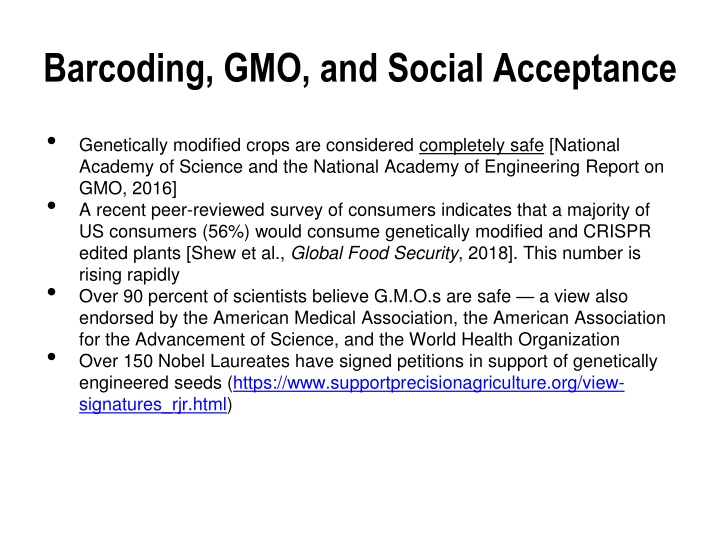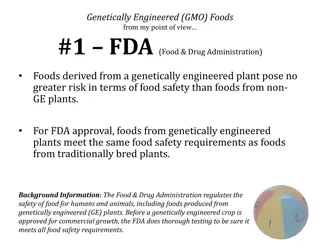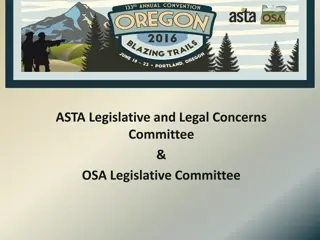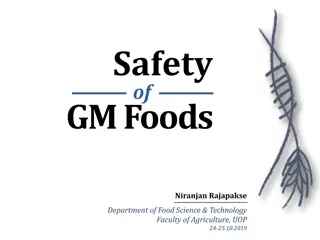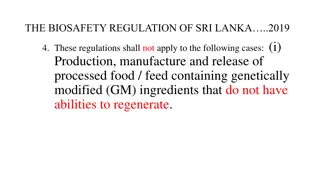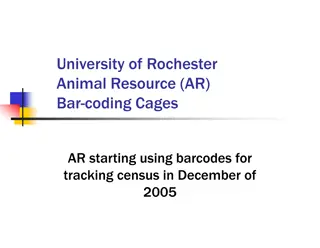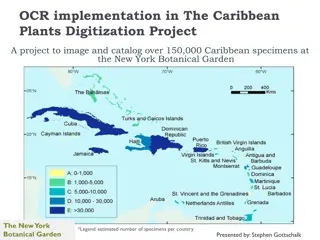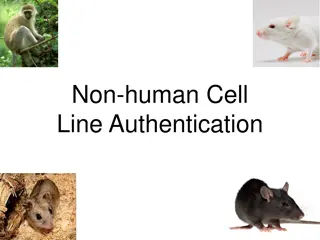Barcoding, GMO, and Social Acceptance
Genetically modified crops are widely accepted as safe and beneficial. The increasing adoption of GMOs and CRISPR-edited plants by consumers, along with approvals from regulatory bodies, reflects the positive impact of genetic engineering on agriculture. Scientists and organizations support the safety and efficiency of GMOs, highlighting the potential for improved crop yields, reduced pesticide use, and enhanced nutritional content. Techniques such as barcoding are advancing the development and identification of genetically engineered crops.
Download Presentation

Please find below an Image/Link to download the presentation.
The content on the website is provided AS IS for your information and personal use only. It may not be sold, licensed, or shared on other websites without obtaining consent from the author.If you encounter any issues during the download, it is possible that the publisher has removed the file from their server.
You are allowed to download the files provided on this website for personal or commercial use, subject to the condition that they are used lawfully. All files are the property of their respective owners.
The content on the website is provided AS IS for your information and personal use only. It may not be sold, licensed, or shared on other websites without obtaining consent from the author.
E N D
Presentation Transcript
Barcoding, GMO, and Social Acceptance Genetically modified crops are considered completely safe [National Academy of Science and the National Academy of Engineering Report on GMO, 2016] A recent peer-reviewed survey of consumers indicates that a majority of US consumers (56%) would consume genetically modified and CRISPR edited plants [Shew et al., Global Food Security, 2018]. This number is rising rapidly Over 90 percent of scientists believe G.M.O.s are safe a view also endorsed by the American Medical Association, the American Association for the Advancement of Science, and the World Health Organization Over 150 Nobel Laureates have signed petitions in support of genetically engineered seeds (https://www.supportprecisionagriculture.org/view- signatures_rjr.html)
FDA/ USDA Approvals USDA deemed two CRISPR-edited crops to be exempt from its review process because neither contained genetic material from species considered to be plant pests U.S. Secretary of Agriculture announced (Mar 2018) that the USDA would not regulate new plant varieties developed using genome editing technologies that would yield plants indistinguishable from those developed through traditional breeding methods Our proposed barcoding techniques use synonymous substitutions on non-coding regions of the genome. The plants are complete indistinguishable from those developed through traditional breeding methods
GMO and Popular Perception For many decades, in addition to traditional crossbreeding, agricultural scientists have used radiation and chemicals to induce gene mutations in edible crops in attempts to achieve desired characteristics. What is different now is the precision with which we can do it! In the decades since the first genetically modified foods reached the market, no adverse health effects among consumers have been found. [https://www.nytimes.com/2018/04/23/well/eat/are-gmo-foods-safe.html]
GMOs are in fact Safer! An analysis of 76 studies published in February 2018 in Scientific Reports by researchers in Pisa, Italy, found that genetically engineered corn has a significantly higher yield than non- genetically modified varieties and contains lower amounts of toxins commonly produced by fungi. By engineering resistance to insect damage, farmers have been able to use fewer pesticides while increasing yields. Gene modification scientists are focusing increasingly on building health benefits into widely used foods (e.g., pink pineapples that contain lycopene, tomatoes that contain antioxidants from blueberries, and golden rice rich in vitamin A). Billions of edible animals are raised in this country each year on feed containing G.M.O.s, with no evidence of harm. In fact, animal health and growth efficiency actually improved on the genetically engineered feed
Embedding Barcodes A number of techniques are available to incorporate watermarks into DNA sequences: Biolistics -- DNA tethered to a gold or titanium nanoparticles shot into plant tissue Use of agrobacterium -- replacing bacterial T-DNA from the bacterial plasmid and with watermarked gene Electroporation -- using electric fields to render the cell membrane permeable to plasmid DNA CRISPR/ Cas9 for fine grained edits on the sequence Appending watermarks to the ends of the sequence through DNA polymerase and a complementary watermark template
